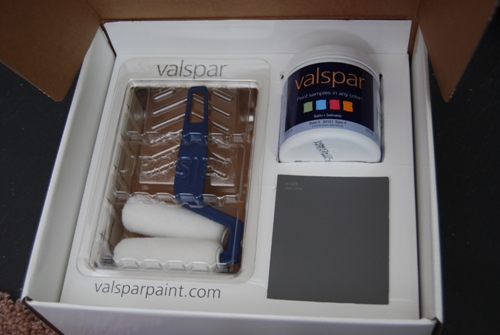Earlier this month I went to change out the arrangement in my fireplace and decided I couldn't stand it one.second.longer.
It was filthy when I moved in and the cleaner we used totally remove most of the paint on the metal side panels. The doors and rust and the bottom grate had striped paint and rust from where Boy Cat pee'd on it. The faux brick back and floor were cracked and stained. The handles were ugly. While pulling out the fall/winter arrangement a bunch more soot fell down out of the chimney. Just all around yuck.
I ran right out and got some high heat primer and tapped off the doors and the wall with newspapers and a plastic tarp. I vacuumed out the soot and I sanded down the rusty spots and removed the grates to paint outside.
After getting everything nice and primed, I realized I wasn't going to be able to find the high heat paint in anything but black in local stores, so I ordered the Stove Bright Charcoal from a vendor on Amazon.
Not the cheapest way to get paint, but I had some credits from my Amazon credit card and I really didn't want the flat black. It's a subtle difference and the color is darker then the cap, which I expected from reading some of the reviews. The lighting is making the finished job look a little spotty, but in real life the coverage is nice and even.
I had one small scare when I removed the newspaper from the glass and realized I hadn't taped off the inside of the small side panels. Ooops. But it removed easily with a Mr. Clean Magic Eraser and a little elbow grease.
I still need to paint the hearth, which is Phase II of this project. I've been eyeing up herringbone and chevron patterned marble mosaics on Pinterest,
 |
| From Here |
 |
| From Here |
but I did not want to deal with all of the cutting that would be involved in this small project, so I decided to try and faux paint it like this example
 |
| From Here |
and this is where the free paint comes in. I was able to cash in on Valspar's March free paint sample offer and got an adorable little kit with a sample of Man Cave (a nice, dark charcoal color), a mini paint tray and roller with two covers, a $5 off coupon, a flyer with some of their new color collections and some sample chips of colors they suggest will coordinate with Man Cave - the two tans they suggest are actually very close to my wall color, so I think I'm on the right track.
I'll use my trim color or other miscellaneous white I have around as the base and do the marbling with the Man Cave and another lighter gray and I think hand paint in the grout lines maybe using a mix of the two grays for a medium tone or maybe going lighter. Stay tuned.
I'm linking this to Thrifty Decor Chick's Spring Spray Paint Party. Stop over and see all the great paint projects!

















